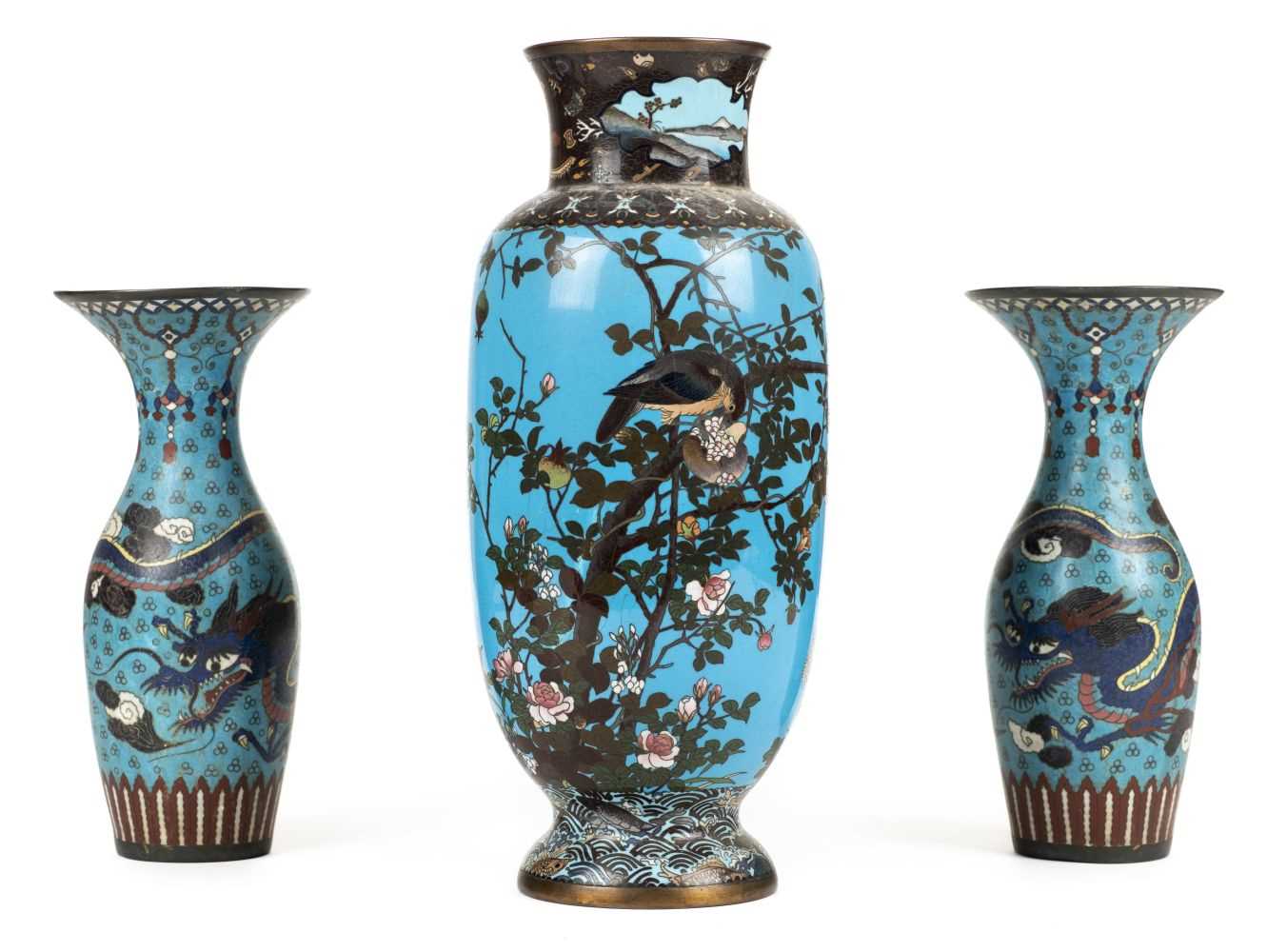A LARGE JAPANESE CLOISONNE ENAMEL PLAQUE IN THE STYLE OF ANDO JUBEI (1876-1953) MEIJI PERIOD, 19TH/20TH CENTURY Depicting a full moon on a dove-grey ground appearing from behind clouds, the scene subtly rendered in musen shippo (wireless) enamels, signed and with two red seal marks for Maruyama Okyo (1735-1795), the reverse with a pattern of V-shaped wires, 52cm x 36.6cm. Provenance: from the collection of Reverend Victor Farmer (1898-1977) and thence by descent. This large plaque features the complex technique of musen shippo or wireless cloisonné enamels. Developed by the artist Namikawa Sosuke and his Shippo Kaisha studio in the late 1870s, the wireless technique allowed artists to create soft pictorial effects such as this diaphanous night scene. Many other artists, including those of Ando Jubei's studio, copied this style of cloisonné by using a variety of methods. One approach was to temporarily attach the wires and remove them once the enamel powders had been applied before firing. Another method was to hide wires under subsequent layers, and a third was to dissolve the wires with sulfuric acid and fill the gaps with a final layer. In all cases the enamels had to be ground flat several times to create a smooth surface for the next layer to be applied; this would have been a time-consuming and painstaking process. Cloisonné makers only rarely created grey monochromatic pieces and even fewer featured designs from Edo-period painters. Although this plaque doesn't bear a mark for the cloisonné maker, it features the signature of the famous painter Maruyama Okyo (1735-1795). Okyo is commonly regarded as one of the greatest artists of 18th century Japan. Coming from a humble farming background, he made his way to Kyoto where he found work painting faces on dolls. Okyo then discovered optical devices featuring pictures with a European perspective, and from there grew his interest for Western paintings. His style developed to offer a unique marriage of Japanese aesthetics, traditional Chinese influence and Western naturalism. Okyo founded the influential Maruyama School of painting, encouraging his students to sketch from life, himself drawing nude figures in varying poses and superimposing clothes afterwards. His art grew enormously popular with the public and the Imperial court from which he would get many important commissions. Read more »
A LARGE JAPANESE CLOISONNE ENAMEL PLAQUE IN THE STYLE OF ANDO JUBEI (1876-1953) MEIJI PERIOD, 19TH/20TH CENTURY Depicting a full moon on a dove-grey ground appearing from behind clouds, the scene subtly rendered in musen shippo (wireless) enamels, signed and with two red seal marks for Maruyama Okyo (1735-1795), the reverse with a pattern of V-shaped wires, 52cm x 36.6cm. Provenance: from the collection of Reverend Victor Farmer (1898-1977) and thence by descent. This large plaque features the complex technique of musen shippo or wireless cloisonné enamels. Developed by the artist Namikawa Sosuke and his Shippo Kaisha studio in the late 1870s, the wireless technique allowed artists to create soft pictorial effects such as this diaphanous night scene. Many other artists, including those of Ando Jubei's studio, copied this style of cloisonné by using a variety of methods. One approach was to temporarily attach the wires and remove them once the enamel powders had been applied before firing. Another method was to hide wires under subsequent layers, and a third was to dissolve the wires with sulfuric acid and fill the gaps with a final layer. In all cases the enamels had to be ground flat several times to create a smooth surface for the next layer to be applied; this would have been a time-consuming and painstaking process. Cloisonné makers only rarely created grey monochromatic pieces and even fewer featured designs from Edo-period painters. Although this plaque doesn't bear a mark for the cloisonné maker, it features the signature of the famous painter Maruyama Okyo (1735-1795). Okyo is commonly regarded as one of the greatest artists of 18th century Japan. Coming from a humble farming background, he made his way to Kyoto where he found work painting faces on dolls. Okyo then discovered optical devices featuring pictures with a European perspective, and from there grew his interest for Western paintings. His style developed to offer a unique marriage of Japanese aesthetics, traditional Chinese influence and Western naturalism. Okyo founded the influential Maruyama School of painting, encouraging his students to sketch from life, himself drawing nude figures in varying poses and superimposing clothes afterwards. His art grew enormously popular with the public and the Imperial court from which he would get many important commissions. Read more »













Try LotSearch and its premium features for 7 days - without any costs!
Be notified automatically about new items in upcoming auctions.
Create an alert